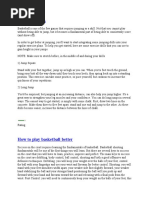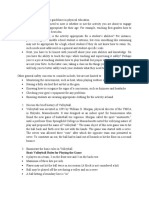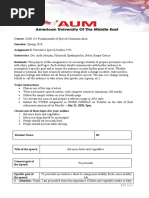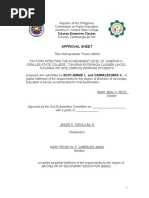0 ratings0% found this document useful (0 votes)
86 viewsHope 2, w5
Hope 2, w5
Uploaded by
YNAFER DE LA CRUZThe document discusses the FITT principle and its application to exercise programs and sports. FITT stands for Frequency, Intensity, Time, and Type. It explains each component of FITT and how to measure intensity. It then discusses technical and tactical skills in volleyball, including serving, passing, attacking, blocking, and diving. Tactical skills include serving to gain advantage, effective spiking, setting up attacks, and communicating with teammates. In sports, FITT applies by gradually increasing exercise frequency over time based on fitness level and goals, to see improvements while lessening health risks from a sedentary lifestyle.
Copyright:
© All Rights Reserved
Available Formats
Download as PPTX, PDF, TXT or read online from Scribd
Hope 2, w5
Hope 2, w5
Uploaded by
YNAFER DE LA CRUZ0 ratings0% found this document useful (0 votes)
86 views31 pagesThe document discusses the FITT principle and its application to exercise programs and sports. FITT stands for Frequency, Intensity, Time, and Type. It explains each component of FITT and how to measure intensity. It then discusses technical and tactical skills in volleyball, including serving, passing, attacking, blocking, and diving. Tactical skills include serving to gain advantage, effective spiking, setting up attacks, and communicating with teammates. In sports, FITT applies by gradually increasing exercise frequency over time based on fitness level and goals, to see improvements while lessening health risks from a sedentary lifestyle.
Original Description:
HOPE
Original Title
hope 2, w5
Copyright
© © All Rights Reserved
Available Formats
PPTX, PDF, TXT or read online from Scribd
Share this document
Did you find this document useful?
Is this content inappropriate?
The document discusses the FITT principle and its application to exercise programs and sports. FITT stands for Frequency, Intensity, Time, and Type. It explains each component of FITT and how to measure intensity. It then discusses technical and tactical skills in volleyball, including serving, passing, attacking, blocking, and diving. Tactical skills include serving to gain advantage, effective spiking, setting up attacks, and communicating with teammates. In sports, FITT applies by gradually increasing exercise frequency over time based on fitness level and goals, to see improvements while lessening health risks from a sedentary lifestyle.
Copyright:
© All Rights Reserved
Available Formats
Download as PPTX, PDF, TXT or read online from Scribd
Download as pptx, pdf, or txt
0 ratings0% found this document useful (0 votes)
86 views31 pagesHope 2, w5
Hope 2, w5
Uploaded by
YNAFER DE LA CRUZThe document discusses the FITT principle and its application to exercise programs and sports. FITT stands for Frequency, Intensity, Time, and Type. It explains each component of FITT and how to measure intensity. It then discusses technical and tactical skills in volleyball, including serving, passing, attacking, blocking, and diving. Tactical skills include serving to gain advantage, effective spiking, setting up attacks, and communicating with teammates. In sports, FITT applies by gradually increasing exercise frequency over time based on fitness level and goals, to see improvements while lessening health risks from a sedentary lifestyle.
Copyright:
© All Rights Reserved
Available Formats
Download as PPTX, PDF, TXT or read online from Scribd
Download as pptx, pdf, or txt
You are on page 1of 31
Technical and Tactical
Skills in playing Sports
What is the FITT Principle?
In the article of Brad Walker in Stretch Coach, he defines the
FITT Principle (or formula) as a great way of monitoring your
exercise program. The acronym FITT outlines the key
components, or training guidelines, for an effective exercise
program. The initials F, I, T, T, stand for: Frequency, Intensity,
Time, and Type. Let’s get know what this FITT principle
acronym means.
What is the FITT Principle?
• Frequency - refers to the frequency of exercise undertaken or
how often you exercise.
• Intensity - refers to the intensity of exercise undertaken or
how hard you exercise.
• Time - refers to the time you spend exercising or how long
you exercise for.
• Type - refers to the type of exercise undertaken or what kind
of exercise you do.
Frequency
The first letter of the acronym is F which stands for frequency.
It is a key component of the FITT Principle. Remember that it is
important to know why you are exercising and what you want
to achieve before rushing into any exercise program (Walker,
2003).
Adjust the number of times you exercise per day/week/month
to reflect: your current fitness level; the time you realistically
have available; your other commitments like family and work;
and the goals you have set for yourself.
Intensity
The second letter I refers to intensity. This is an extremely
important aspect of the FITT Principle and is probably the
hardest factor to monitor. If you don’t want to spend the
money on a heart rate monitor, simply count your heart rate
over a 15 second period. All you need is a wristwatch that has a
“second’s” display. Feel for your heartbeat by either placing
your hand over your heart or by feeling for your pulse in your
neck or on your wrist. Count the beats over a 15 second period
and then multiply by 4. This will give you your exercise heart
rate in beats per minute (Walker, 2003).
Time
The time you spend exercising is also an important part of the
FITT Principle. The time dedicated to exercise usually depends
on the type of exercise undertaken. For example, it’s
recommended that to improve cardio-vascular fitness you’ll
need at least 30 minutes of nonstop exercise. For weight loss,
more time is required; at least 40 minutes of moderate weight
bearing exercise. However, when talking about the time
required for muscular strength improvements, time is often
measured as several “sets” and “reps.” A typical
recommendation would be 3 sets of 8 reps (Walker, 2003).
Type
The type of exercise you choose will have a big effect on the
results you achieve. That is why it is important to know what
you want to gain from your efforts. For example, if you’re
looking to improve your cardio-vascular fitness, then exercises
like walking, jogging, swimming, bike riding, stair climbing,
aerobics and rowing are very effective. For weight loss, any
exercise that uses most of your large muscle groups will be
effective. These exercises include squatting and mountain
climbing. To improve muscular strength, the best exercises,
include the use of free weights, machine weights and body
weight exercises like push-ups, chin-ups, and dips (Walker,
2003).
Tactical and Technical Skills of Sports
In playing any sport, learning, and developing skills help
athletes improve in the game. These skills involve physical
training and game strategies. Technical skills are the basics of
playing the game (e.g., basketball-dribble, shoot, pass) while
tactical skills are the strategies to take advantage during the
game.
Volleyball is one of the most played sports all over the country.
Some may just play it for fun but it is better for each to know
the technical and tactical skills in playing volleyball.
Volleyball
Technical Skills
There are different types of shots and
skills in volleyball. The following shots
involved in volleyball are the serve,
passing and attacking (dig, set and
spike.)
Serve
Firstly, the serve is the first shot to start the
game and score a point. A good serve will
score you a point or put the opposition (the
other team) at a disadvantage position. A poor
serve is when the serve does not go over the
net or is not controlled and goes out of
bounds. A serve should score points and not
just to get the ball over the net.
There are 2 types of serving shots,
the floater and topspin.
a. Floater - is a shot by tossing and
hitting the ball
with your palm through the center of
the ball.
b. Topspin - is a shot when you toss
and hit the ball
with your palm with contact just below
the center of the ball making it spin.
Passing
Passing involves a sequence
of 3 shots in between you
team without someone in the
team doing 2 consecutive
shots. It is a tactic to set up
for a strike attack. Therefore,
it is passing the ball by hitting
it to set up to score points.
Dig
Usually, the passing sequences begins
with a dig (receive). A dig is the most
common shot in volleyball. It is an
accurate shot that is controlled. The dig
is usually performed to keep the ball up
and is the first shot when the attacking
team hits it over. It involves having your
hands together and arms straight and
hitting the ball. The ball is struck on the
forearms. The dig shot is the first shot of
the 3 passing shots.
Setting
The following shot after the dig is called
the setting shot or the set shot. It is an
overhand or overhead shot. The shot is
controlling the ball hitting it straight-up
above and relatively close to the net. It
involves using your thumb, index, and
middle finger of both hands to toss the
ball up. The set shot is setting up for the
last shot out of the 3 shots. This shot is
usually the 2nd shot and is a tactic for
setting up the 3rd shot.
Spike
Lastly the final shot of the 3 is to attack the
opposition. Once the setting shot is in the air a
player from the team would perform the spike shot.
A spike shot is fast direct shot to the opposition’s
side of the net. It involves a player to jump up for
the ball once the ball is in the air from the controlled
set shot. Due to the set shot being above the net
and close. The player who jumped for the spike can
angle the spike shot in a downward angle in the
opponent’s side of the court.
A spike is a lethal
attacking move that
usually scores the
points. A spike involves
using your palm and
angling your wrist
downwards on the ball
to create topspin.
Defensive Tactics
It’s no surprise that the success of a volleyball
team depends a lot on its defense. Obviously, a
volleyball team should have defensive players,
who must be able to resist attacks of the
opposite team successfully. You need to know
that the defensive tactic in volleyball is all about
blocking as well as diving, rolling, and sliding.
Blocking
A well timed and effective block will diffuse an
attack. Players near the net when defending
will jump up with their arms out and attempt
to block the shot coming over the net. This is a
defensive tactic that blocks a spike. Blockers
would jump up and just before the net
because they cannot touch the net or cross it.
Hands when blocking should be
positions downwards and open
this is because it could be a
great attacking tactic to. When
the ball is blocked it may return
in the opponent’s side of the
court and they might not be
able to react quickly enough
and score you a point.
Therefore, a block is a great
tactic for both defense and
attack.
Diving, rolling and
sliding
Clearly instead of just letting the ball
hit the ground (your side of the court)
and let the other team score the point
be brave and dive, slide or roll instead
while reaching for the ball (dig or
recieve). It’s a great tactic to defend a
spike because the spike is coming fast
and is hard to defend. When you dive,
slide or roll you are getting low and are
covering more area of defense around
the court better than just standing
there.
Tactical Skills
Mastery of the technical skills of volleyball is important,
but you must also learn the tactics of the game.
Tactical skills are defined as “the decisions and actions
of players in the contest to gain an advantage over the
opposing team or players” (Martens, Successful
Coaching, p. 170). Basic volleyball resources might
focus on the technical skills of the game and may
overlook the tactical aspects.
Serve
Serve is an important shot because it is the first
shot that begins the point. Therefore, if you do a
good serve it puts the other team under
pressure, so your team have an advantage.
Whereas if you do a poor serve which is easier
for the other team the pressure will be on your
team. Don’t just serve the ball to just get it over
the net. Serve the ball to score the point or
dominate the start of the point.
Spike
The spike is a great
attacking tactic. A spike is a
lethal fast shot in a
downwards motion that
would score you most of
your points and if it doesn’t
score you a point it still
scrambles your opponent
and puts pressure on them.
Setting shot
The set shot is great for
controlling the ball and setting
up for an attack. It’s a great
tactic for your team to set up
and score points.
Communication
Communication is a huge tactic in all codes of
sport. Communication plays an important role in
volleyball. In volleyball communication is a great
tactic for attacking and defending. This is
because your team is communicating to each
other who are taking the shot and whose ball it
is. Therefore, it makes the game much easier.
How does FITT apply in sports?
Let us correlate what we have just learned. Remember our goal is
to become healthier and physically fit lessening the risk of being
obese due to the routine use of computers, cellular phones, tablets,
and other gadgets.
Frequency – We begin with playing volleyball once a week with
friends and family then progress to 2 times a week until it becomes
a daily routine. During the progression you will observe that you are
able to cope with the demands of the sport with improvement to
your cardiovascular endurance at the same time losing some
weight and body fat. As you progress further, you will not only
develop your tactical and technical skills but also improve the
shape and tone of your body.
How does FITT apply in sports?
Intensity – Your skill level improves as you progress in
playing the sport from beginner to advanced. So does the
intensity of your game. Progressing from moderate to
vigorous intensity of the game include more and more
combination of offensive and defensive tactics from both
teams. Scoring a point will now take more time and effort. As
the intensity of the game goes up so does your
cardiovascular endurance. Your heart rate will be slower
compared to the first time you played the sport as your
cardiovascular system is now well adapted to the physical
demands of the sport.
Time – Getting hooked up to the sport allow you to crave
for more and not just be contented of your fitness level. You
will want to practice more to improve your skills both
offensively and defensively. Even the duration of the game
becomes longer. With your skills getting better and better,
you will have opponents that is equally or far better than
your team. The game sets will now take longer to finish as
both teams will have more combination of offensive and
defensive tactics before one can score a point. And equally,
as the game progresses from beginners to advanced so
does the game sets. Initially it will be just a single set and it
will progress to best of three to best of five game sets.
Type – To maintain a well-balanced fitness level as
well as skill level to the sport, one must perform a
variety of exercises including cardio, strengthening,
and flexibility training. For volleyball, progressing
from beginner to advanced encompasses
improvements in cardio-vascular fitness, weight loss
and muscular strength. As you become more
competitive to the sport, you will learn new offensive
and defensive tactics that you have not learned
before. Most of the time these new tactics is more
difficult to perform and demand more endurance,
flexibility, strength, and agility.
Direction: Choose one sport and cut out
pictures showing the Technical and Tactical
Skills in the sport. Label the pictures
according to skill and paste in your activity
notebook
You might also like
- Setter GuideDocument10 pagesSetter GuideVoleibol CangasdeOnisNo ratings yet
- Defensive PhilosophyDocument54 pagesDefensive PhilosophyImam machdiNo ratings yet
- How To Improve Your Soccer Team Players - Elite Book For Elite PlayerFrom EverandHow To Improve Your Soccer Team Players - Elite Book For Elite PlayerNo ratings yet
- Pe Quarter 3 Week 6Document4 pagesPe Quarter 3 Week 6Jahjah BantayaNo ratings yet
- UntitledDocument7 pagesUntitledGLORIFE RIVERALNo ratings yet
- Tactical and Technical Skills of SportsDocument5 pagesTactical and Technical Skills of SportsMa. cHristine L. RetiroNo ratings yet
- Document 6Document7 pagesDocument 6Dyssa Jane Manrique AynipNo ratings yet
- Pe11 Team SportsDocument30 pagesPe11 Team SportsGene Paul TabisauraNo ratings yet
- Court Dimension: Overall DimensionsDocument5 pagesCourt Dimension: Overall DimensionsAbby GaleNo ratings yet
- REPORT SA PATHFIT Patts 1Document9 pagesREPORT SA PATHFIT Patts 1John paul AustriaNo ratings yet
- ShootingDocument27 pagesShootingBikram HansdahNo ratings yet
- Basic Volleyball SkillsDocument8 pagesBasic Volleyball SkillsMei KookNo ratings yet
- P.E 4 Modules Final TermDocument18 pagesP.E 4 Modules Final TermJerylle Luz PerezNo ratings yet
- Coaching Defensive LinemenDocument28 pagesCoaching Defensive LinemenRyanNo ratings yet
- Volleyball Spike TechniquesDocument18 pagesVolleyball Spike TechniquesMaría Cancino0% (1)
- Training3 (Lomu Pop)Document11 pagesTraining3 (Lomu Pop)Bryan Abdul AzizNo ratings yet
- Angeles, VB Training ProgrammeDocument12 pagesAngeles, VB Training ProgrammeJohn RavenNo ratings yet
- Week 4 Module Grade 9Document5 pagesWeek 4 Module Grade 9Levy John SabulaoNo ratings yet
- Module 2 VolleyballDocument8 pagesModule 2 VolleyballVincent FranciscoNo ratings yet
- Jumping DrillsDocument4 pagesJumping DrillsBanica AndreyNo ratings yet
- P.E. NOTES 4TH QDocument15 pagesP.E. NOTES 4TH QclarencejakejernalimNo ratings yet
- Defensive Back's Fundamentals and DrillsDocument10 pagesDefensive Back's Fundamentals and DrillsFabz44100% (2)
- Volleyball StrategiesDocument5 pagesVolleyball StrategiesSaldi VitorilloNo ratings yet
- Lexington Youth Basketball AssociationDocument101 pagesLexington Youth Basketball AssociationViyoung Kush100% (1)
- Basketball ProjectDocument3 pagesBasketball ProjectJasa JezersekNo ratings yet
- 10 Ways To Hit VolleyballDocument7 pages10 Ways To Hit Volleyballfurrymarsh1No ratings yet
- Individual Soccer TrainingDocument39 pagesIndividual Soccer TrainingScribdTranslationsNo ratings yet
- Mental Training For TennisDocument10 pagesMental Training For TennisJulemar LucasNo ratings yet
- How To Attack Effectively - Roy Saunders Sep 2007Document5 pagesHow To Attack Effectively - Roy Saunders Sep 2007Juan Pablo Varela de la ColinaNo ratings yet
- Netball Eca Notes TeacherDocument3 pagesNetball Eca Notes TeacherWendy HatiikaNo ratings yet
- League G Practice PlanDocument15 pagesLeague G Practice PlanZam BisuNo ratings yet
- Splitbacks and I Formation - Playbook 1 - FinalDocument48 pagesSplitbacks and I Formation - Playbook 1 - FinalЕлена Нельсон100% (6)
- Ebook Combing The 3.3.5 - 4.25Document248 pagesEbook Combing The 3.3.5 - 4.25hrivas34434036100% (3)
- Pe Quarter 4 - Week 4Document36 pagesPe Quarter 4 - Week 4Mherasul PasayloNo ratings yet
- Tactics and Strategy in SquashDocument12 pagesTactics and Strategy in Squashjuanperez32No ratings yet
- P.E Basic SkillsDocument5 pagesP.E Basic SkillsCheska LandichoNo ratings yet
- Tactics and Strategy in SquashDocument12 pagesTactics and Strategy in SquashSANTIAGO RESTREPO ZAPATANo ratings yet
- How To Play Basketball BookDocument78 pagesHow To Play Basketball BookWes ArtNo ratings yet
- PEH Notes 2nd Sem FinalsDocument4 pagesPEH Notes 2nd Sem FinalsElah PacaNo ratings yet
- The Fundamental Skills Used in Playing Volleyball: FloaterDocument32 pagesThe Fundamental Skills Used in Playing Volleyball: FloaterSanny RamosNo ratings yet
- 1000 Touch Workout Introduction and Philosophy: P.O. Box 130 Leesport, PA 19533Document9 pages1000 Touch Workout Introduction and Philosophy: P.O. Box 130 Leesport, PA 19533Moreno LuponiNo ratings yet
- Nicky Tennis TipsDocument23 pagesNicky Tennis Tipsdavidusc2010No ratings yet
- Katlego LesegoDocument11 pagesKatlego LesegoOnkabetse LesegoNo ratings yet
- How To Coach Young Defensive LinemenDocument3 pagesHow To Coach Young Defensive LinemenElias GiannopoulosNo ratings yet
- Youth Basketball Curriculum K 3Document8 pagesYouth Basketball Curriculum K 3Andhi PrionoNo ratings yet
- Pe Coursework A2 FootballDocument4 pagesPe Coursework A2 Footballafiwjkfpc100% (2)
- December 2020 Module Physical Education 8Document9 pagesDecember 2020 Module Physical Education 8Christian jade Quijano100% (1)
- Dominant O-Line ChalkboardDocument25 pagesDominant O-Line ChalkboardJJ Lawson86% (7)
- Coaching Canadian Football DefenseDocument55 pagesCoaching Canadian Football DefenseRon TNo ratings yet
- 1st 2nd Grade Basketball Coaching ManualDocument22 pages1st 2nd Grade Basketball Coaching Manualdsealey10-1No ratings yet
- Aqa A2 Pe Coursework NetballDocument4 pagesAqa A2 Pe Coursework Netballbcr1vtj5100% (2)
- How To Watch Training Camp PracticeDocument4 pagesHow To Watch Training Camp PracticeskanzeniNo ratings yet
- Offensive Line ManualDocument40 pagesOffensive Line Manualmountainthinair100% (4)
- Basic Skill For VolleyballDocument4 pagesBasic Skill For VolleyballMary Irish Charles De OcampoNo ratings yet
- Tips and Drills For Offensive Linemen - 1Document77 pagesTips and Drills For Offensive Linemen - 1DobsonFootballNo ratings yet
- Basic Volleyball Rules For Playing The GameDocument6 pagesBasic Volleyball Rules For Playing The GameBae RonaNo ratings yet
- Basketball Training For Speed Agility and QuicknessDocument6 pagesBasketball Training For Speed Agility and QuicknessAlbert StoneNo ratings yet
- Cardiorespirato Ry Endurance and FlexibilityDocument11 pagesCardiorespirato Ry Endurance and FlexibilityYNAFER DE LA CRUZNo ratings yet
- UntitledDocument2 pagesUntitledYNAFER DE LA CRUZNo ratings yet
- HGP, Q3, Mod 6Document30 pagesHGP, Q3, Mod 6YNAFER DE LA CRUZNo ratings yet
- Quiz, Hope 2, Week2Document3 pagesQuiz, Hope 2, Week2YNAFER DE LA CRUZ100% (1)
- Trend Week 2, Q1Document29 pagesTrend Week 2, Q1YNAFER DE LA CRUZNo ratings yet
- Immersion, W2Document39 pagesImmersion, W2YNAFER DE LA CRUZNo ratings yet
- Deped Order No. 40, S. 2012Document32 pagesDeped Order No. 40, S. 2012YNAFER DE LA CRUZNo ratings yet
- Trends Week 1, Q1Document40 pagesTrends Week 1, Q1YNAFER DE LA CRUZNo ratings yet
- Statement Letter For Offline Final ParticipationDocument3 pagesStatement Letter For Offline Final ParticipationDina RovivahNo ratings yet
- PictogramsDocument3 pagesPictogramstechnoworld lalazar2No ratings yet
- Journal Club EOEDocument38 pagesJournal Club EOEAhsan ShafiqNo ratings yet
- Poster Analisis DRP PCNEDocument1 pagePoster Analisis DRP PCNEMUHAMMAD FAUZAN NAJMINo ratings yet
- Aim High 2 Unit 5 TextDocument4 pagesAim High 2 Unit 5 TextJ E S T E R J E S T E RNo ratings yet
- Guidelines - Gas Detection Baseline Value For Operational System in Open AreaDocument8 pagesGuidelines - Gas Detection Baseline Value For Operational System in Open Areantdduc.ngoNo ratings yet
- Trial Room DecisionDocument45 pagesTrial Room DecisionNew York Daily NewsNo ratings yet
- How To Make Plans - Execute Them by Rahul BhatnagarDocument16 pagesHow To Make Plans - Execute Them by Rahul BhatnagarIrfan BasheerNo ratings yet
- Sustainability Report 2019Document63 pagesSustainability Report 2019Daniela SafforesNo ratings yet
- Radiography Test of Pipe Joints NightDocument6 pagesRadiography Test of Pipe Joints NightVIctor OdususiNo ratings yet
- Muhammad Bilal HSE OfficerDocument2 pagesMuhammad Bilal HSE OfficerMuhammad BilalNo ratings yet
- PE 11 Learning Activities 3Document3 pagesPE 11 Learning Activities 3Ron LiwanagNo ratings yet
- Employee Retention WorkbookDocument19 pagesEmployee Retention WorkbookMOHAMMAD KAWSAR JAHANNo ratings yet
- Certification: Day of June 2021 at Cresencia Village Barangay, Bado Dangwa ST., George C. FangroyDocument18 pagesCertification: Day of June 2021 at Cresencia Village Barangay, Bado Dangwa ST., George C. FangroyCresencia VillageNo ratings yet
- Rafi Covid CertificateDocument1 pageRafi Covid CertificateMuhammad Rafi sayedNo ratings yet
- 60 Things To Be Thankful For in LifeDocument7 pages60 Things To Be Thankful For in LifeMarina MeirelesNo ratings yet
- Đề cương nội nha rte manhDocument24 pagesĐề cương nội nha rte manhMai Anh NguyenNo ratings yet
- Landlord Code of ConductDocument8 pagesLandlord Code of Conductryan paul zamoraNo ratings yet
- Theories and Models For Midwifery For The First Time in The Nordic RegionDocument2 pagesTheories and Models For Midwifery For The First Time in The Nordic RegionSANANo ratings yet
- Referential Thinking ScaleDocument12 pagesReferential Thinking ScaleRoy AyersNo ratings yet
- Innovation in Nursing CurrentDocument30 pagesInnovation in Nursing Currentbemina jaNo ratings yet
- Lost Spring Stories of Stolen Childhood by Anees JungDocument7 pagesLost Spring Stories of Stolen Childhood by Anees Junganish gagNo ratings yet
- The Effect of Cinnamon TeaDocument5 pagesThe Effect of Cinnamon TeaLintan lara saptiNo ratings yet
- Eating Fruits and Vegetables Persuasive WritingDocument5 pagesEating Fruits and Vegetables Persuasive WritingShireen BatoolNo ratings yet
- Literature Review FinalDocument14 pagesLiterature Review Finalapi-375292749No ratings yet
- Presentation of DataDocument31 pagesPresentation of DataMike Faustino SolangonNo ratings yet
- Misinformation About COVID-19: Evidence For Differential Latent Profiles and A Strong Association With Trust in ScienceDocument12 pagesMisinformation About COVID-19: Evidence For Differential Latent Profiles and A Strong Association With Trust in SciencegamerriddlesNo ratings yet
- Supervised Learningclassification Part2Document13 pagesSupervised Learningclassification Part2Avinash KumarNo ratings yet
- Histopathology Handbook CP SOP 43Document20 pagesHistopathology Handbook CP SOP 43Davindu Anushka0% (1)
- Approval Sheet: Tukuran Extension ClassesDocument16 pagesApproval Sheet: Tukuran Extension ClassesDenny Rose IslamNo ratings yet

































































































